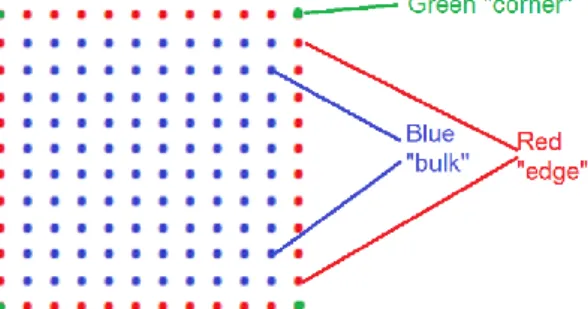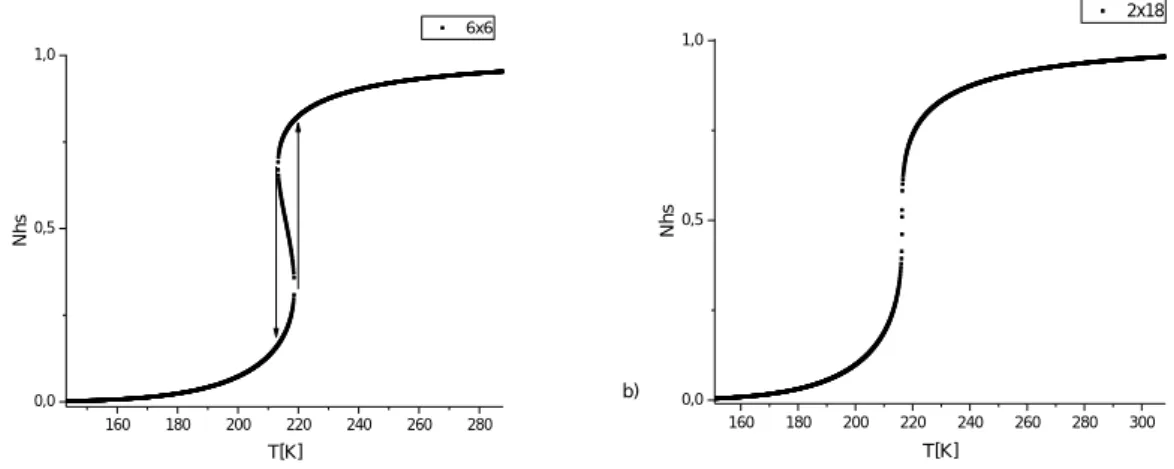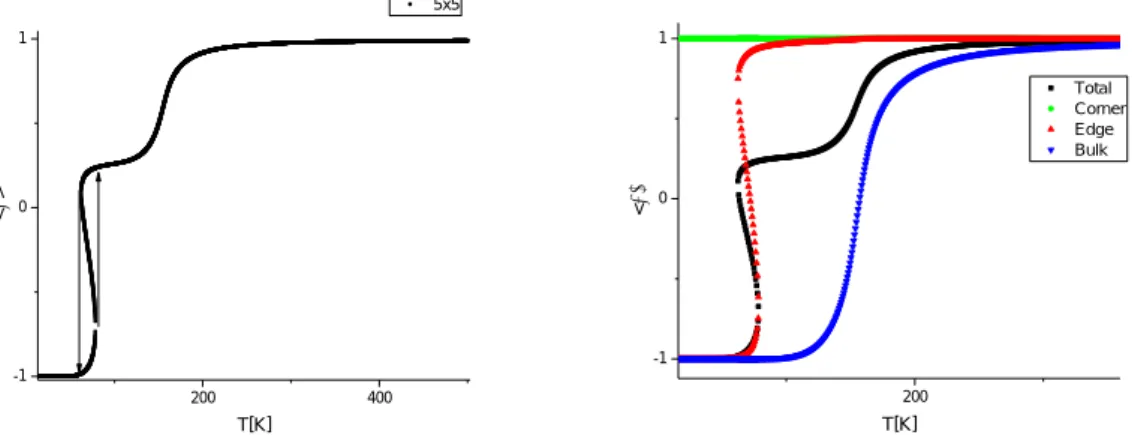HAL Id: insu-01575684
https://hal-insu.archives-ouvertes.fr/insu-01575684
Submitted on 26 Jan 2018HAL is a multi-disciplinary open access archive for the deposit and dissemination of sci-entific research documents, whether they are pub-lished or not. The documents may come from teaching and research institutions in France or abroad, or from public or private research centers.
L’archive ouverte pluridisciplinaire HAL, est destinée au dépôt et à la diffusion de documents scientifiques de niveau recherche, publiés ou non, émanant des établissements d’enseignement et de recherche français ou étrangers, des laboratoires publics ou privés.
2D Spin Crossover Nanoparticles described by the
Ising-like model solved in Local Mean-Field
Approximation
Salah Eddine Allal, Jorge Linares, K. Boukheddaden, Pierre-Richard Dahoo,
F. de Zela
To cite this version:
Salah Eddine Allal, Jorge Linares, K. Boukheddaden, Pierre-Richard Dahoo, F. de Zela. 2D Spin Crossover Nanoparticles described by the Ising-like model solved in Local Mean-Field Approxima-tion. Journal of Physics: Conference Series, IOP Publishing, 2017, 936, pp.012052. �10.1088/1742-6596/936/1/012052�. �insu-01575684�
Journal of Physics: Conference Series
PAPER • OPEN ACCESS
2D Spin Crossover Nanoparticles described by the Ising-like model
solved in Local Mean-Field Approximation
To cite this article: Salah Eddine Allal et al 2017 J. Phys.: Conf. Ser. 936 012052
View the article online for updates and enhancements.
1
Content from this work may be used under the terms of theCreative Commons Attribution 3.0 licence. Any further distribution of this work must maintain attribution to the author(s) and the title of the work, journal citation and DOI.
Published under licence by IOP Publishing Ltd
1234567890
ICMSQUARE IOP Publishing
IOP Conf. Series: Journal of Physics: Conf. Series 936 (2017) 012052 doi :10.1088/1742-6596/936/1/012052
2D Spin Crossover Nanoparticles described by the Ising-like
model solved in Local Mean-Field Approximation
Salah Eddine Allal,1,2 Jorge Linares,1,2 K. Boukheddaden,1 Pierre Richard
Dahoo,2
F.
de Zela31GEMAC, Université de Versailles Saint-Quentin-en-Yvelines, 45 Av. des Etats-Unis,
CNRS-UMR 8635, 78035 Versailles Cedex, France
2LATMOS, Université de Versailles-Saint-Quentin-en-Yvelines, CNRS-UPMC-UVSQ (UMR
8190), 11 boulevard d'Alembert, 78280 Guyancourt, France
3 Departemento de Ciencias, Sección Física, Pontificia Universidad Católica del Perú,
Apartado 1761, Lima, Perú.
Abstract: Some six-coordinate iron (II) coordination compounds exhibit thermal-, optical-, electrical-, magnetic- and pressure-induced switching between the diamagnetic low-spin (LS, S=0) and the paramagnetic high-spin (HS; S=2) states [1]. This may lead to potential application of these complexes in molecular devices such as temperature and pressure sensors [2]. An Ising-like model has been proposed to explain the occurrence of the thermal hysteresis behaviour [3,4] of this switchable solids. In this contribution, the local mean field approximation is applied to solve the Hamiltonian modelling interactions pertaining to 2D nanoparticles embedded in a magnetically-inactive matrix.
1. Introduction
It is very well known that spin-transition phenomena are related to the thermodynamic competition between high-spin (HS) and low-spin (LS) states of spin-crossover (SCO) molecules. Spin-transition phenomena can be triggered by various external perturbations such as temperature, pressure, light and magnetic fields[1-7]. During the occurrence of the SCO phenomenon, several physical properties of the material (magnetic, optical, electrical, vibrational, etc.) can change dramatically, making it possible to track the process by using various detection techniques (magnetometry, optical spectroscopy, Mössbauer, calorimetry, dielectric constant, etc.).
In this work, we implement an approach based on the mean field approximation, which is commonly employed as a first step when trying to construct a more accurate theory. Actually, there are many possible mean field models, but they all share the same spirit. Here we deal with a local mean field approximation (LMFA), which takes into account for the dependence of the number of neighbors on whether the molecules are in the bulk or at the border (or on the surface) of the lattice. By this LMFA, we study both shape and size effects on the SCO compounds.
2. Model and principle of calculation
Various physical techniques and methods, such as magnetic, optical and vibration spectroscopy, X-ray diffraction and heat capacity measurements are used to study the behaviour of switching SCO materials. To reproduce the different results obtained by these techniques, researchers have proposed different models such as atom-phonon coupling[8-9], Ising-like[10-11-12-13] or mechano-elastic and electro-elastic[14] coupling. One can predict the way SCO materials react to external factors, depending on
2
1234567890
ICMSQUARE IOP Publishing
IOP Conf. Series: Journal of Physics: Conf. Series 936 (2017) 012052 doi :10.1088/1742-6596/936/1/012052
their lattice architecture and the short- and long-range interactions among the particles of the materials. In this work, we have applied a local mean field approximation of the Ising-like model using realistic parameters to calculate and obtain the bi-stability property of the spin state. This will help to get more information about the switching properties of the complex under study. The Ising-Like model proposed by Wajnsflasz and Pick uses a fictitious spin operator σ, whose eigenvalues, ±1 correspond to the high-spin (HS) state and to the low-spin (LS) state, respectively, whose degeneracies are denoted by gHS for the high spin and gLS for the low spin. The Hamiltonian is written in this form:
Here, Δ represents the difference between the energy of the HS and the energy of the LS state, ∑(i,j) is the sum over nearest neighbors and g=gHS/gLS is the degeneracy ratio. We can express the fraction of high
spin, in terms of the average value as
.
In the usual homogeneous mean-field approximation, the total Hamiltonian writes:and then:
Where q is the number of neighboring sites considered here as independent on the site i. Because our Hamiltonian is of the form , it readily follows that is given by the equation
where,
and
.
To determine the thermal-dependence of the average magnetization, one must solve the following equation:
For a "classical" homogeneous mean field in the case of a 2D square lattice, the used coordination number is q = 4. This approximation remains valid as long as we consider an infinite lattice, which means that the surface effects are negligible. In this work, we study nanoparticles, for which surface and border effects play a significant role on their properties. To include these effects, we take into account that the number of neighbors for each molecule depends on its position (see Fig. 1).
Figure 1. Matrix of particles, (Green) corner, (Red) edge, (Blue) bulk.
As we see in Fig. 1, for a 2D nanoparticle, in a square lattice, we have three types of sites or atoms: corner, edge and bulk atoms. Thus, atoms at a “corner” (green dots in Fig. 1) have two neighboring sites while particles located on the “edge” (red dots)have three neighbors and those of the bulk (in blue) connect to four neighbors. If we take into account the interactions between the molecules with the environment, we must include the term for “corner” and “edge” molecules.
In the following, we consider that the bulk, edge and corner magnetizations are different, and that the mean-field approximation can be applied to each of these sites, which means that we consider a local
3
1234567890
ICMSQUARE IOP Publishing
IOP Conf. Series: Journal of Physics: Conf. Series 936 (2017) 012052 doi :10.1088/1742-6596/936/1/012052
mean-field. So, to obtain the average value of the spin state we need to write the corresponding expression for each type of atom, which gives:
•
for the corner•
for the edge•
And for the bulkThe average magnetization over the lattice is easily obtained as from the expression of each spin type, as follows
Where NC (=4) NE (= 4N-8) and NB (=(N-2) 2
) are, respectively, the number of corner, edge and bulk particles and NT (=N
2
) is the total number of particles.
To fully understand the evolution of the hysteresis, it is worth mentioning that in our case, the
first-order phase transition takes place only when the condition TOD>Teq is satisfied. Here, TOD. is the
average order-disorder (or Curie) temperature of the corresponding pure Ising model solved in the local mean-field approximation, by considering Δ/kB = 0 K, ln(g)= 0, L/kB = 0 K. One can easily find:
where
and
and
The analytical expression of the order-disorder transition is obtained as
Which indeed gives for large systems ( ).
Similarly, Teq is the average value of the transition temperature. It reads
with :
and
and
4
1234567890
ICMSQUARE IOP Publishing
IOP Conf. Series: Journal of Physics: Conf. Series 936 (2017) 012052 doi :10.1088/1742-6596/936/1/012052
Which gives for an infinite system,
.
The calculation of the previous two temperatures, and and , help us to predict the presence or not of a thermal hysteresis loop according to the lattice size and model parameters. Table 1 shows these temperatures as a function of the principal model parameters.
Table 1. Order-desorder and equilibrium temperatures calculated for different sizes and shapes.
Nx Ny J Delta L TOD (LMFA) Teq (LMFA) TOD (MFA) Teq (MFA) 20 20 70 1300 500 266 183,0283 280 216,3062 15 15 70 1300 500 261,3333 171,9357 280 216,3062 10 10 70 1300 500 252 149,7504 280 216,3062 6 6 75 1300 0 250 216,3062 300 216,3062 2 18 75 1300 0 216,6667 216,3062 300 216,3062 5 5 70 1300 500 224 83,19468 280 216,3062 5 5 70 1300 0 224 216,3062 280 216,3062 5 5 70 1300 100 224 189,6839 280 216,3062
3. Results and discussion
200 -1 0 LMFA MFA < > T[K]
Figure 2. Difference between the homogeneous mean field approximation (red curve) and the local MFA (black curve) with border effects for a 5x5 lattice; parameter values: Δ/kB = 1300 K, ln(g)=6.01, J/kB = 70 K, L/kB = 0
K.
Fig.2 shows results obtained by the classical MF (CMFA) and the “local” mean field approximations proposed in this contribution. We observe the presence of a thermal hysteresis of the average magnetization in the CMFA while it disappears in LMFA for a 5x5 lattice, due to a decrease of the effective coordination number. Indeed the latter is equal to 4 in the CMFA while it becomes equal to
5
1234567890
ICMSQUARE IOP Publishing
IOP Conf. Series: Journal of Physics: Conf. Series 936 (2017) 012052 doi :10.1088/1742-6596/936/1/012052
Which gives the effective value 3.2 for , which then reduces the effective short-range interaction energy, and so the order-disorder transition. The advantage of the LMFA is the possibility to study the effect of the shape of the compound on the the thermal properties, through the change of the number of “edge” molecules, which increases for a rectangular case, for example compared to the square with the same total number of sites. Fig.3 shows the thermal behavior of the high spin fraction for a square (Fig.3.a) and for a rectangular (Fig.3.b) shaped-lattice. We see that the hysteresis obtained in a 6x6 lattice disappeared for the 2x18 one, due to the increase of the number of edge particles with respect to the number of “bulk” particles, something which reflects the reduction of the effective number of neighbors. 160 180 200 220 240 260 280 0,0 0,5 1,0 6x6 Nhs T[K] a) 160 180 200 220 240 260 280 300 0,0 0,5 1,0 2x18 Nhs T[K] b)
Figure 3. Thermal behavior of the high spin fraction for two lattice shapes using the Local Mean Field Approximation. (a) square-shaped of 6x6 lattice, (b) rectangular-shaped 2x18 lattice. Parameter values are Δ/kB
= 1300 K, ln(g)=6.01, J/kB = 75 K, L/kB = 0 K.
We have also studied the environmental effect by introducing the term in the Hamiltonian for the surface molecules. In this case, we start by studying a 5x5 lattice with a low value of L/kB = 100 K
(Fig.4) and we observe the recurrence of hysteresis compared with the result of LMFA in Fig. 1. This behavior is explained by the reduction of the transition temperature Teq due to environmental effects.
200 -1 0 1 5x5 < > T[K]
Figure 4. Thermal behavior of Sigma for a 5x5 lattice using the Local Mean Field Approximation, parameter values are: Δ/kB = 1300 K, ln(g)=6.01, J/kB = 70 K, L/kB = 100 K.
By rising the strength of the environment interaction to L/kB = 500 K, the result we obtain is a double step
transition with a remarkable hysteresis in the first step (Fig.5.a), this behavior being due to the interplay between the three contributions corner and edge effects which lead to the lower hysteresis and the bulk which leads to the gradual transition with a higher equilibrium temperature, as we can clearly see in Fig.
6
1234567890
ICMSQUARE IOP Publishing
IOP Conf. Series: Journal of Physics: Conf. Series 936 (2017) 012052 doi :10.1088/1742-6596/936/1/012052
5b where we represented separately the corresponding thermal dependence of all these sites. Interestingly for the chosen values of and L, each corner site experiences a negative effective ligand field K, which prevents any spin transition and stabilizes these sites in the HS state as seen in Fig. 5b. So finally, the double step transition in this case is the result of the competition between the bulk and the edge thermal transitions.
200 400 -1 0 1 5x5 < > T[K] 200 -1 0 1 Total Corner Edge Bulk < T[K]
Figure 5. Thermal behavior of <σ> for a 5x5 lattice using the Local Mean Field Approximation. (a) The total variation of the spin state, (b) the variation of corners “green circles”, edge ”red up triangles” and bulk’s “blue down triangles spin state regarding the total variation. Parameter values are Δ/kB = 1300 K, ln(g)=6.01, J/kB =
70 K, L/kB = 500 K.
The local mean field approximation gives us the possibility to analyze the size effect for different cases, on the transition phenomena, as shown in Fig.6, where we have summarized the thermal behavior of the total HS fraction for different square lattices. It is worth noticing that for small sizes (5x5) the first order transition is driven by the surface (edge) atoms while the bulk atoms undergo a gradual transition. This situation is reversed for big sizes (20x20) where the surface effects become less significant and the first-order transition turns to the bulk material, while the transition of edge sites becomes gradual. This interplay between edge and bulk atoms on the characteristics of the thermal transition is very interesting and deserves to be investigated more deeply in future works.
0 200 400 0,0 0,2 0,4 0,6 0,8 1,0 5x5 10x10 15x15 20x20 Nhs T[K]
Figure 6. The simulated thermal behavior of the fraction of high spin for different system sizes, 5x5 (black square), 10x10 (red circle), 15x15 (green triangle), 20x20 (blue star); Parameter values are Δ/kB = 1300 K,
7
1234567890
ICMSQUARE IOP Publishing
IOP Conf. Series: Journal of Physics: Conf. Series 936 (2017) 012052 doi :10.1088/1742-6596/936/1/012052
4. Conclusion
We have shown that the mean-field approximation (MFA) is successful in qualitatively explaining the critical behavior of SCO macroscopic compounds, and that the Local Mean Field Approximation (LMFA) can complement the last one when performing calculations on SCO nanoparticles, in which the number of molecules at the surface or corners with different number of neighbors becomes important and it could not be ignored. In particular, we found that combined with the matrix effects, the LMFA brought to light the existence of double step transitions, resulting from the thermodynamic interplay between the core and the edge molecules. We have also demonstrated that by increasing the size effects, the LMFA allows to find out the usual MFA and the role of the bulk atoms in driving the first-order spin transition in macroscopic lattice sizes.
Acknowledgments
The present work has been supported by the French “ministère de la recherché”, University of Versailles, CNRS and ANR BISTA-MAT: ANR-12-BS07-0030-01, whose support is highly appreciated. CHAIR Materials Simulation and Engineering, UVSQ, University Paris Saclay is gratefully acknowledged.
References
[1] P. Gütlich, H.A. Goodwin, Topics in Current Chemistry, Spin Crossover in transitions Metal Compounds I-III, edited by Springer, Heidelberg, Berlin 2004.
[2] Gütlich P, Gaspar AB and Garcia Y Beilstein J. Org. Chem. 9 342 (2013). [3] Hauser A. ,Coord. Chem. Rev. 111,(1991) 275-290.
[4] Varret F., Bleuzen A., Boukheddaden K., Bousseksou A., Coldjovi E., Enachescu C., Goujon A., Linares J., N.Menendez N. And M. Verdaguer M., Pure Appl. Chem., 74, (2002) 2159-2168. [5] Enachescu C., Linares J., Varret F., J. Phys.: Condens, Matter, 13,(2001) 2481-2495.
[6] Seredyuk M. Gaspar AB, Ksenofontov V, Reiman S, Galyametdinov Y, Haase W, Rentschler E, Gütlich P Chem. Mater. 18 2513 (2006).
[7] Mishra V., Mukherjee R., Linares J., Balde C., Desplanches C., Létard J.F., Collet E., Toupet L., Castro M., Varret F., Inorg Chemistry, 47, (2008) 7577-7587.
[8] Nasser J A European Physical Journal B 21 (2001) 3-10
[9] Nasser J A, Boukheddaden K and Linares J European Physical Journal B 39 (2004) 219-27. [10] Wajnflasz J, Pick R, J. Phys.Colloques, 32, (1971) 91-92.
[11] Bousseksou A. Nasser J, Linares J, Boukheddaden K, Varret F j. Physique I 2 1381 (1992). [12] Linares J, Jureschi C, Boukheddaden K, Magnetochemistry, 2, 24 (2016).
[13] Linares J, Jureschi C, Boulmaali A, Boukheddaden K, Physica B, 486, (2016) 164-168.
[14] Slimani A., Boukheddaden K., Varret F., Oubouchou H., Nishino M., and Miyashita S. , Phys. Rev. B 87, 014111 (2013).



